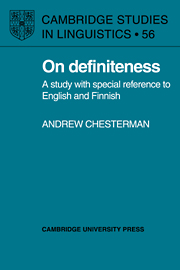Book contents
- Frontmatter
- Contents
- Acknowledgements
- 1 Introduction
- 2 English articles: the research traditions
- 3 English article usage
- 4 A unified description of the English articles
- 5 Finnish: no articles
- 6 Finnish spesies
- 7 The status of definiteness in Finnish
- 8 English and Finnish contrasted
- 9 Wider perspectives
- References
- Author index
- Subject index
8 - English and Finnish contrasted
Published online by Cambridge University Press: 18 September 2009
- Frontmatter
- Contents
- Acknowledgements
- 1 Introduction
- 2 English articles: the research traditions
- 3 English article usage
- 4 A unified description of the English articles
- 5 Finnish: no articles
- 6 Finnish spesies
- 7 The status of definiteness in Finnish
- 8 English and Finnish contrasted
- 9 Wider perspectives
- References
- Author index
- Subject index
Summary
Towards a tertium comparationis
I have so far been discussing English and Finnish separately, partly in terms of the respective research traditions in the two languages (chapters 2 and 6). My own conclusions have also been stated independently for each language (chapters 4 and 7). It will now be instructive to set the two descriptions side by side. A unified analysis of definiteness in both languages would make explicit any correspondences between the two, and also raise hypotheses about the theory of definiteness in general (a topic to be taken up in chapter 9).
But before we proceed to a contrastive analysis a general caveat is in order. Throughout this study – and even more so in the present chapter – I make one assumption which should now be made explicit: I have implicitly ‘reified’ definiteness. That is, I have been taking definiteness as some kind of independent ‘phenomenon’ (albeit a composite one), which manifests itself in various ways in different languages. The implication has been that definiteness is a potential semantic universal. At the level of analysis at which I am operating I hold this assumption to be valid and helpful. But beneath this abstraction there lies an issue that marks practically any linguistic argument: the relation between the technical linguistic terms (such as ‘definite’) and the empirical reality they purport to describe.
- Type
- Chapter
- Information
- On DefinitenessA Study with Special Reference to English and Finnish, pp. 162 - 180Publisher: Cambridge University PressPrint publication year: 1991



